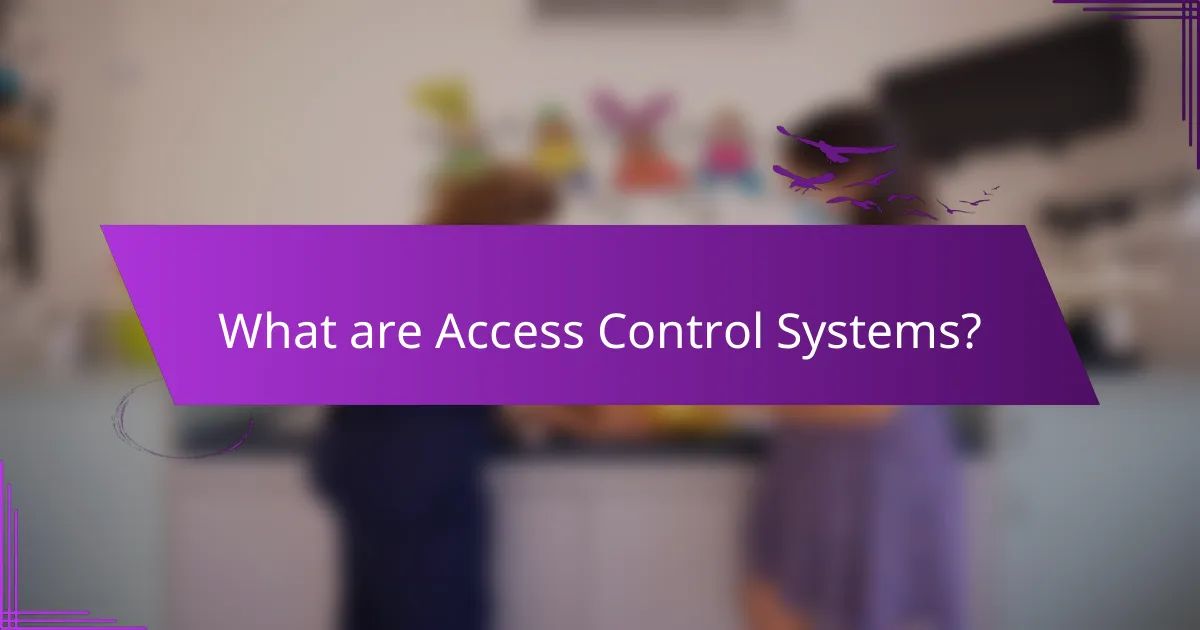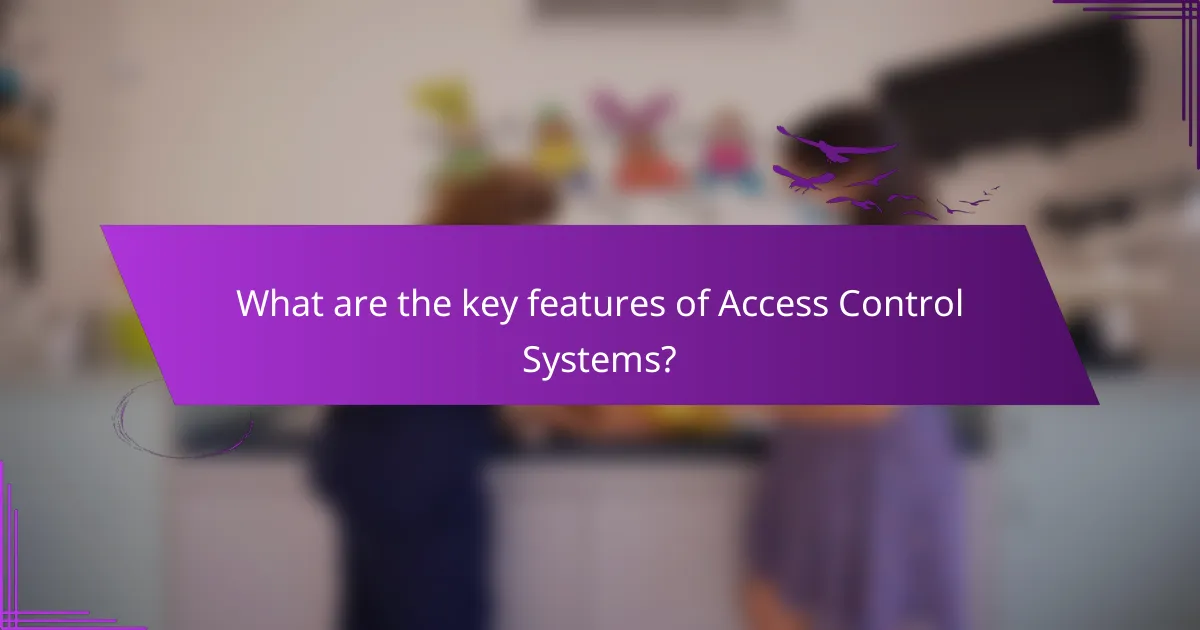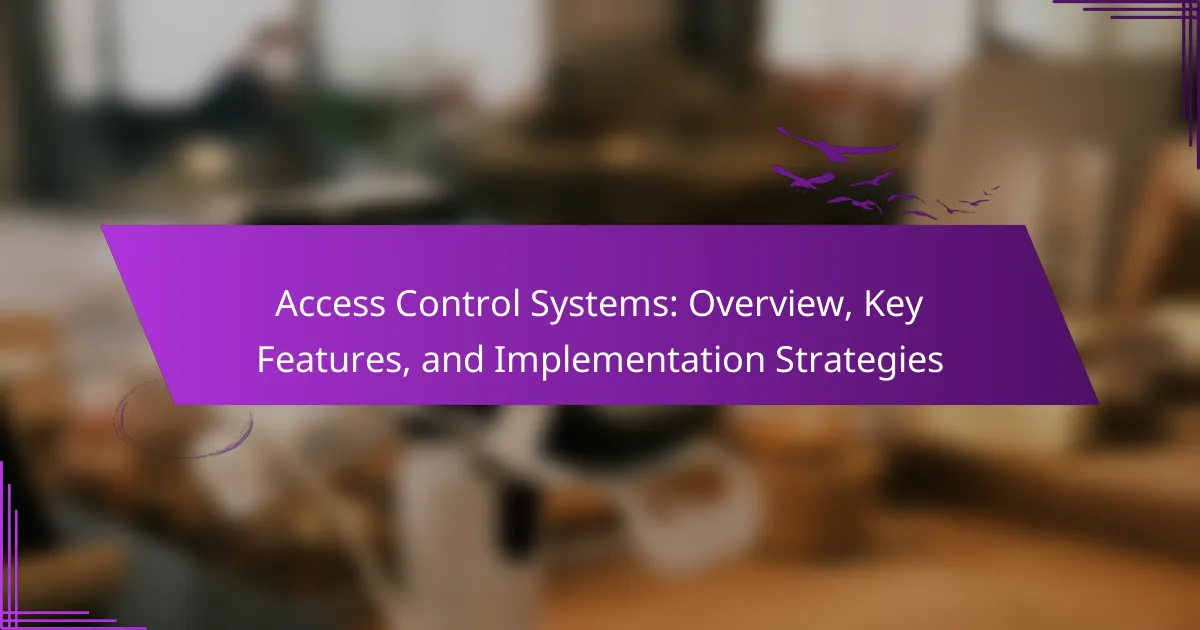
What are Access Control Systems?
Access control systems are security measures that regulate who can access specific resources or areas. They are commonly used in physical security and information security. These systems can include hardware and software components. Examples of access control systems are keycard entry systems and biometric scanners. They work by verifying the identity of individuals before granting access. Access control systems help protect sensitive information and physical assets. According to a report by MarketsandMarkets, the global access control market is projected to reach $10.4 billion by 2025, indicating its growing importance in security.
How do Access Control Systems function?
Access control systems function by regulating who can enter or access certain areas or information. They utilize identification methods such as key cards, biometric scans, or passwords. Upon presentation of credentials, the system verifies the user’s identity against a database. If the credentials match, access is granted; if not, access is denied. Access control systems can be centralized or decentralized, affecting how they manage user permissions. They often include logging features to track access attempts. This tracking can enhance security by providing audit trails. Overall, access control systems are essential for protecting sensitive areas and information in various environments.
What are the key components of Access Control Systems?
The key components of Access Control Systems include authentication, authorization, and auditing. Authentication verifies the identity of users or devices. This process can utilize passwords, biometrics, or smart cards. Authorization determines the access rights of authenticated users. It defines what resources a user can access and what actions they can perform. Auditing tracks access and usage of resources. This component helps in monitoring and reviewing access events for security compliance. Together, these components ensure secure and efficient access management.
How do these components interact within the system?
Access control system components interact through a defined communication protocol. The main components include access control panels, readers, and locks. Access control panels process data from readers. Readers capture user credentials from cards or biometric inputs. Locks execute commands from the access control panel to grant or deny entry. This interaction ensures that only authorized individuals gain access. The system logs all access attempts for security audits. Each component relies on the others to maintain security integrity. This integrated approach enhances overall system efficiency and reliability.
What types of Access Control Systems are available?
There are several types of access control systems available. The main categories include discretionary access control (DAC), mandatory access control (MAC), role-based access control (RBAC), and attribute-based access control (ABAC). DAC allows users to control access to their resources based on their discretion. MAC enforces access controls based on predefined security labels. RBAC assigns access based on user roles within an organization. ABAC grants access based on attributes of the user, resource, and environment. Each type serves different security needs and organizational structures.
What are the differences between physical and logical access control?
Physical access control restricts access to physical locations. This includes security measures like locks, gates, and security personnel. Logical access control, on the other hand, manages access to digital resources. This involves authentication methods such as passwords, biometrics, and encryption.
The primary difference lies in their focus. Physical access control protects tangible assets, while logical access control safeguards information systems. Both types are essential in a comprehensive security strategy. They work together to ensure both physical and digital environments are secure from unauthorized access.
How do biometric and non-biometric systems compare?
Biometric systems use unique physical traits for identification, while non-biometric systems rely on something users possess or know. Biometric systems often include fingerprint, [censured] recognition, and iris scanning technologies. These systems provide high security as they are difficult to replicate or steal. Non-biometric systems include key cards, passwords, and PINs. These are more susceptible to loss or theft, which can compromise security. According to a study by the National Institute of Standards and Technology, biometric systems have a lower false acceptance rate compared to traditional password systems. This makes biometrics generally more reliable for access control. However, biometric systems may require more complex infrastructure and maintenance. Non-biometric systems tend to be simpler and cheaper to implement.
What are the benefits of implementing Access Control Systems?
Implementing Access Control Systems enhances security and protects sensitive information. These systems restrict unauthorized access to facilities and data. They enable organizations to monitor who accesses specific areas or information. This capability reduces the risk of theft and vandalism. Access Control Systems also facilitate compliance with regulations, such as GDPR and HIPAA. By controlling access, companies can ensure only authorized personnel handle sensitive data. Additionally, these systems can integrate with other security measures, improving overall safety. In fact, according to a study by the Security Industry Association, 70% of organizations report reduced security incidents after implementing access control solutions.
How do Access Control Systems enhance security?
Access control systems enhance security by regulating who can access specific areas and resources. They use identification methods like keycards, biometrics, or PIN codes. This ensures that only authorized personnel can enter restricted zones. By tracking access events, these systems provide audit trails for accountability. Real-time monitoring alerts security personnel to unauthorized attempts. They also integrate with other security measures, such as surveillance cameras. According to a study by the Security Industry Association, effective access control reduces security breaches by up to 50%. Thus, access control systems play a crucial role in maintaining a secure environment.
What cost savings can organizations expect from Access Control Systems?
Organizations can expect significant cost savings from Access Control Systems. These systems reduce the need for physical security personnel. Automated access management minimizes human error and enhances efficiency. They lower costs associated with theft and unauthorized access incidents. Additionally, Access Control Systems streamline visitor management, reducing administrative burdens. Maintenance costs are often lower compared to traditional security measures. According to a study by the Security Industry Association, organizations can save up to 30% on security-related expenses with effective access control solutions. Overall, the integration of these systems leads to long-term financial benefits.

What are the key features of Access Control Systems?
Access control systems primarily feature authentication, authorization, and auditing. Authentication verifies user identity through methods like passwords or biometrics. Authorization determines access levels based on user roles and permissions. Auditing logs access events for security monitoring and compliance. Additionally, access control systems may include centralized management, allowing for easier administration of user permissions. They often support remote access, enabling users to connect securely from various locations. Integration with other security systems, such as alarms and surveillance, enhances overall security. These features collectively ensure that only authorized individuals gain access to sensitive areas or information.
What functionalities do Access Control Systems typically include?
Access Control Systems typically include functionalities such as authentication, authorization, and access management. Authentication verifies the identity of users through methods like passwords, biometrics, or key cards. Authorization determines what resources users can access based on their roles or permissions. Access management involves monitoring and controlling user access to ensure compliance with security policies. These systems may also feature logging and reporting to track access events. Integration with other security systems, such as alarm systems or video surveillance, enhances overall security. Additionally, remote access capabilities allow users to manage access from different locations. These functionalities collectively contribute to the effectiveness of Access Control Systems in securing physical and digital environments.
How does user authentication work in Access Control Systems?
User authentication in Access Control Systems verifies the identity of individuals seeking access. This process typically involves the use of credentials such as usernames and passwords. Users input their credentials into the system for validation. The system checks these credentials against a stored database. If the credentials match, access is granted. If not, access is denied. Additional layers may include biometric data or security tokens. These enhance security by providing unique identifiers. Statistics show that multi-factor authentication reduces unauthorized access significantly.
What role does access logging play in security management?
Access logging plays a critical role in security management by tracking user activities on a system. It records who accessed what resources and when. This information is vital for identifying unauthorized access attempts. Access logs help in forensic investigations after a security breach. They provide a timeline of actions leading up to an incident. Additionally, regular review of access logs can reveal patterns of suspicious behavior. This proactive monitoring supports compliance with security policies and regulations. According to the National Institute of Standards and Technology (NIST), maintaining access logs is essential for effective incident response and risk management.
How do Access Control Systems ensure compliance with regulations?
Access Control Systems ensure compliance with regulations by enforcing user authentication and authorization protocols. These systems help organizations manage who can access sensitive information and areas. They log access events, creating an audit trail that demonstrates compliance with regulations like GDPR and HIPAA. Regular updates and security patches maintain system integrity and protect against vulnerabilities. Additionally, Access Control Systems can be configured to meet specific regulatory requirements. This adaptability ensures that organizations can comply with evolving legal standards. By automating compliance checks, these systems reduce the risk of human error and enhance accountability.
What standards should Access Control Systems meet?
Access Control Systems should meet several key standards to ensure security and reliability. These standards include ISO/IEC 27001 for information security management. They also align with NIST SP 800-53 for security and privacy controls. Compliance with GDPR is essential for data protection in the European Union. Additionally, systems should adhere to PCI DSS if handling payment information. The UL 294 standard addresses the performance of access control systems. Meeting these standards enhances trust and effectiveness in protecting sensitive areas.
How can Access Control Systems help in maintaining data privacy?
Access control systems help maintain data privacy by restricting access to sensitive information. They ensure that only authorized users can view or modify data. This minimizes the risk of data breaches and unauthorized access. Access control systems utilize various methods, such as role-based access control and multi-factor authentication. These methods provide layers of security that protect data integrity. According to a report by the Ponemon Institute, organizations with robust access control measures experience 50% fewer data breaches. This statistic underscores the effectiveness of access control systems in safeguarding data privacy.
What are the common challenges in Access Control Systems?
Common challenges in Access Control Systems include security vulnerabilities, integration issues, and user management difficulties. Security vulnerabilities can arise from outdated software or hardware, making systems susceptible to breaches. Integration issues often occur when new access control systems do not seamlessly connect with existing security infrastructure. User management difficulties involve complications in assigning, modifying, or revoking access rights, which can lead to unauthorized access. Additionally, scalability can be a concern as organizations grow and need to expand their access control measures. Finally, compliance with regulations can pose challenges, as organizations must ensure their systems meet legal requirements.
How can organizations address integration issues with existing systems?
Organizations can address integration issues with existing systems by conducting a thorough assessment of current infrastructure. This assessment identifies compatibility gaps and areas needing improvement. Next, organizations should implement middleware solutions that facilitate communication between disparate systems. Middleware can translate data formats and protocols, ensuring smooth data exchange. Additionally, adopting standardized APIs can enhance integration capabilities. Standardized APIs enable different systems to interact seamlessly. Organizations can also invest in training staff on integration tools and processes. Educated staff can troubleshoot issues more effectively, reducing downtime. Regularly updating systems and software can prevent future integration problems. Keeping systems current ensures compatibility with new technologies.
What are the potential vulnerabilities in Access Control Systems?
Potential vulnerabilities in Access Control Systems include weak authentication methods, improper configuration, and insufficient access control policies. Weak authentication can allow unauthorized users to gain access. Improper configuration of access controls can lead to privilege escalation. Insufficient access control policies can result in users having more permissions than necessary. These vulnerabilities can expose sensitive data and compromise system integrity. According to a study by the National Institute of Standards and Technology, 70% of security breaches are related to access control failures.

What are effective implementation strategies for Access Control Systems?
Effective implementation strategies for Access Control Systems include thorough planning, risk assessment, and stakeholder involvement. Begin with a comprehensive analysis of security needs. Identify potential risks and vulnerabilities in the environment. Engage stakeholders to gather input and ensure alignment with organizational goals. Choose the appropriate technology based on the analysis. Options may include biometric systems, key cards, or mobile access. Establish clear policies and procedures for access control. Train staff on the system’s operation and security protocols. Regularly review and update the system to address new threats and improve efficiency. These strategies enhance security and ensure effective access management.
How should organizations assess their access control needs?
Organizations should assess their access control needs by conducting a thorough risk analysis. This involves identifying sensitive assets and determining who requires access to them. Organizations should evaluate potential threats and vulnerabilities that could compromise these assets. They must also consider compliance requirements relevant to their industry.
Additionally, organizations should analyze current access control measures and their effectiveness. This evaluation helps identify gaps or weaknesses in existing systems. Engaging stakeholders in the assessment process ensures that all perspectives are considered. Finally, organizations should review and update their access control policies regularly to adapt to changing needs.
What factors should be considered during the assessment process?
During the assessment process for access control systems, several factors must be considered. First, the specific security requirements of the facility should be evaluated. This includes identifying sensitive areas that need restricted access. Next, the types of users needing access must be determined. Different user roles may require different levels of access.
Additionally, the technology used for access control should be assessed. This encompasses hardware and software capabilities, such as biometric systems or keycard readers. The integration with existing security systems is also critical. Ensuring compatibility can enhance overall security effectiveness.
Cost factors should not be overlooked. Budget constraints will influence the choice of access control solutions. Lastly, regulatory compliance must be considered. Adhering to legal standards is essential for operating security systems. These factors collectively ensure a comprehensive assessment process.
How can organizations prioritize their access control requirements?
Organizations can prioritize their access control requirements by assessing their specific security needs. They should identify critical assets that require protection. Next, organizations must classify users based on their roles and responsibilities. This classification helps determine the level of access needed for each user.
Conducting a risk assessment is essential to identify potential threats and vulnerabilities. Organizations should evaluate the impact of unauthorized access on their operations. Regulatory compliance requirements also play a significant role in prioritizing access controls.
Implementing a tiered access model can help manage permissions effectively. Lastly, regular reviews of access controls ensure they remain aligned with changing organizational needs. These steps create a structured approach to prioritizing access control requirements.
What steps are involved in implementing Access Control Systems?
Identify the requirements for the Access Control System. This includes understanding security needs and user roles. Next, select the appropriate technology and hardware. This may involve choosing between biometric, card-based, or mobile access systems. Then, design the system layout. This involves mapping out the locations of access points and control panels.
After that, install the hardware and software components. Ensure proper integration with existing security systems. Following installation, configure user access levels. This should align with organizational policies and user roles.
Finally, conduct testing and training. Testing ensures the system functions correctly. Training prepares users to operate the system effectively. These steps ensure a successful implementation of Access Control Systems.
How do organizations select the right Access Control System?
Organizations select the right Access Control System by assessing their specific security needs. They evaluate the size and layout of their facility. Organizations also consider the types of access control methods available, such as biometric, card-based, or mobile access. Budget constraints play a crucial role in the selection process. Additionally, organizations review the scalability of the system for future growth. Compatibility with existing security infrastructure is another critical factor. They also prioritize user-friendliness for staff training and operation. Finally, organizations often seek recommendations or reviews from similar businesses to inform their decision.
What training is necessary for staff to effectively use Access Control Systems?
Staff must undergo comprehensive training to effectively use Access Control Systems. This training typically includes understanding system components and functionalities. Employees need to learn how to manage user access levels. Familiarity with security protocols and compliance regulations is crucial. Training should also cover incident response procedures. Hands-on practice with the system enhances user confidence. Regular updates and refresher courses are necessary to maintain proficiency. Effective training leads to improved security and operational efficiency.
What best practices should organizations follow when implementing Access Control Systems?
Organizations should follow several best practices when implementing Access Control Systems. First, they must conduct a risk assessment to identify vulnerabilities. This assessment helps in determining the level of access required for different roles. Next, organizations should establish a clear access control policy. This policy defines user roles and their corresponding permissions.
Additionally, implementing the principle of least privilege is crucial. Users should only have access necessary for their job functions. Regularly reviewing and updating access rights is also important. This ensures that permissions remain appropriate as roles change.
Training employees on security awareness is another key practice. Educated users are less likely to fall victim to security breaches. Finally, organizations should use multi-factor authentication. This adds an extra layer of security to protect sensitive information.
These practices enhance security and help organizations comply with regulations.
How can regular audits improve Access Control System performance?
Regular audits can significantly enhance Access Control System performance by identifying vulnerabilities and ensuring compliance. They allow organizations to review access permissions and detect any unauthorized access attempts. Regular audits help in identifying outdated or unnecessary permissions, which can be revoked to tighten security.
Furthermore, audits provide insights into user behavior and access patterns. This information can be used to optimize access controls based on actual usage. According to a study by the National Institute of Standards and Technology (NIST), regular reviews can reduce security incidents by up to 30%.
By systematically addressing weaknesses, organizations can improve their overall security posture and ensure that access control measures are effective and aligned with current policies.
What are the key maintenance tasks for ensuring system reliability?
Key maintenance tasks for ensuring system reliability include regular software updates, hardware inspections, and performance monitoring. Software updates fix bugs and enhance security. Hardware inspections identify wear and tear before failures occur. Performance monitoring tracks system functionality and detects anomalies. Regular backups protect data integrity and facilitate recovery. Documentation of maintenance activities ensures accountability and informs future tasks. These practices collectively contribute to sustained system performance and reliability.
What troubleshooting tips can help with Access Control Systems?
Check power supply connections to ensure the system is receiving adequate power. Inspect wiring for any visible damage or loose connections. Verify that access control software is up to date and properly configured. Test the functionality of keypads or card readers to ensure they are operational. Review access logs for any error messages that may indicate issues. Restart the control panel to reset the system and clear temporary faults. Ensure that user access permissions are correctly set and not conflicting. Consult the manufacturer’s manual for specific troubleshooting steps related to the model in use.
Access Control Systems are security measures designed to regulate access to specific resources or areas, encompassing both physical and information security. This article provides a comprehensive overview of access control systems, detailing their functionality, key components, and various types, such as discretionary and role-based access control. It also addresses the differences between physical and logical access control, the benefits of implementation, and strategies for ensuring compliance with regulations. Additionally, the article outlines effective implementation strategies, best practices, and troubleshooting tips to enhance system performance and reliability.
